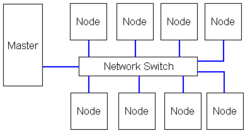Beowulf cluster: Difference between revisions
imported>Eric M Gearhart (Fixing links (red is ugly, blue is pretty)) |
imported>Eric M Gearhart m (link fix again) |
||
| Line 1: | Line 1: | ||
[[Image:Simple Beowulf Cluster Diagram.png|right|thumb|250px|In a Beowulf cluster, the network cables (shown in blue) that connect the eight nodes to the master serve as a [[bus]]]] | [[Image:Simple Beowulf Cluster Diagram.png|right|thumb|250px|In a Beowulf cluster, the network cables (shown in blue) that connect the eight nodes to the master serve as a [[bus]]]] | ||
A '''Beowulf cluster''' is a class of supercomputer, specifically one that utilizes "Commerical Off the Shelf" (COTS) hardware such as [[ | A '''Beowulf cluster''' is a class of supercomputer, specifically one that utilizes "Commerical Off the Shelf" (COTS) hardware such as [[|personal computer|personal computers]] and [[Computer network|Ethernet switches]] to link the machines together so that they act as one. This is known as [[distributed computing]]. | ||
At its most basic level Beowulf is a library of software which one uses to help implement a [[distributed computing|distributed application]]. This software includes facilities such as providing a global [[PID|process id]], methods of [[remote execution]] of [[process|processes]], etc. <ref name="Donald Becker at NYLUG">{{cite web | At its most basic level Beowulf is a library of software which one uses to help implement a [[distributed computing|distributed application]]. This software includes facilities such as providing a global [[PID|process id]], methods of [[remote execution]] of [[process|processes]], etc. <ref name="Donald Becker at NYLUG">{{cite web | ||
Revision as of 11:45, 11 April 2007

A Beowulf cluster is a class of supercomputer, specifically one that utilizes "Commerical Off the Shelf" (COTS) hardware such as [[|personal computer|personal computers]] and Ethernet switches to link the machines together so that they act as one. This is known as distributed computing.
At its most basic level Beowulf is a library of software which one uses to help implement a distributed application. This software includes facilities such as providing a global process id, methods of remote execution of processes, etc. [1]
This type of cluster is composed of a 'master' (which coordinates the processing power of the cluster) and usually many 'nodes' (computers that actually perform the calculations). The 'master' typically is server-class, and has more horsepower (i.e. Memory and CPU power) than the individual nodes. The nodes in the cluster don't have to be identical, although to simplify deployment this is usually the case.
Usually the Beowulf 'nodes' are running Linux,[2] however this is not required, as both Mac OS X and FreeBSD clusters have been created.[3][4]
Beowulf Development
In early 1993, NASA scientists Donald Becker and Thomas Sterling began sketching out the details of what would become a revolutionary way to build a cheap supercomputer: link low-cost desktops together with commodity, off the shelf (COTS) hardware and combine their performance.[5]
By 1994, under the sponsorship of the "High Performance Computing & Communications for Earth & Space Sciences" (HPCC/ESS)[6] project, the Beowulf Parallel Workstation project at NASA's Goddard Space Flight Center had begun.[7] [8]
Popularity in High-Performance Computing
Today Beowulf systems are deployed worldwide as both as "cheap supercomputers" and as more traditional high-performance projects, chiefly in support of number crunching and scientific computing.
It should be noted that more than 50 percent of the machines on the Top 500 List of supercomputers [9] are clusters of this sort.[5]
External links
The Linux Beowulf HOWTO, from the Linux documentation project
References
- ↑ "From Word Processors to Super Computers: Donald Becker Speaks about Beowulf at NYLUG" (Retreived 11-April-2007).
- ↑ "Beowulf Project Overview" (Retreived 08-April-2007).
- ↑ "Mac OS X Beowulf Cluster Deployment Notes" (Retreived 08-April-2007).
- ↑ "A small Beowulf Cluster running FreeBSD" (Retreived 08-April-2007).
- ↑ 5.0 5.1 "The inside story of the Beowulf saga" (Retreived 11-April-2007).
- ↑ "High Performance Computing & Communications for Earth & Space Sciences homepage" (Retreived 11-April-2007).
- ↑ "Donald Becker's Bio at Beowulf.org" (Retreived 11-April-2007).
- ↑ "Beowulf History from beowulf.org" (Retreived 11-April-2007).
- ↑ "TOP500 Supercomputer Sites" (Retreived 11-April-2007).